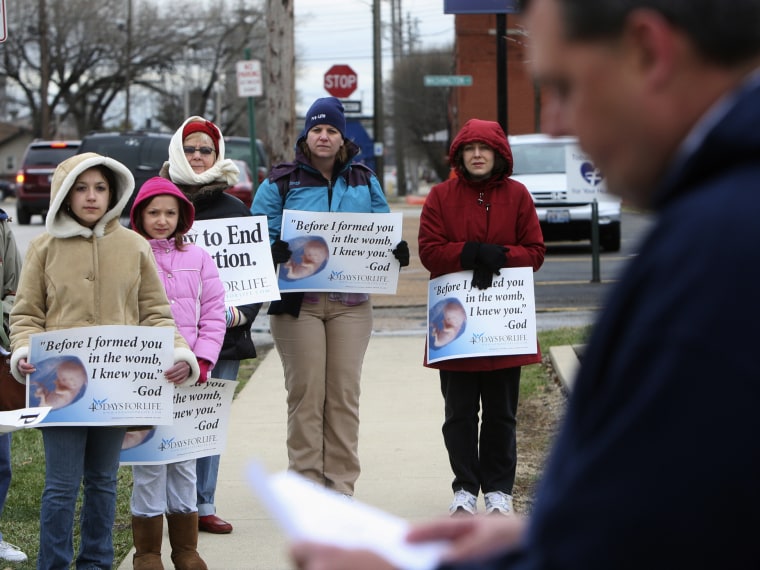Forty years after Roe v. Wade, the decision itself is intact, but in wide swaths of the country, safe, legal abortion looks more like a privilege than a right. Some 87% of U.S. counties lack a single abortion provider. As state legislators devise new ways to restrict women’s access, and physicians eschew the procedure to avoid threats and intimidation, the prospects for reproductive freedom can start to look bleak. But technology may yet hold a trump card. Two pills (mifepristone and misoprostol) can end a pregnancy just as safely and effectively as surgery during the first nine weeks. And as new research from Iowa makes clear, those pills could still fill a big gap in our reproductive health care system.
Medication abortion has grown steadily since 2000, when the FDA approved the main drug in the regimen, yet its potential is still largely untapped. The abortion pill is not available through pharmacies, only through clinics―and many rural clinics lack MDs with prescribing privileges. If the nearest full-service abortion clinic is 200 miles away, chances are the nearest abortion pill is too. But that’s where technology comes in. “Telemedicine”―the use of videoconferencing to connect doctors and patients remotely―is helping to fill various gaps in rural health care. It has recently expanded access to psychiatrists, orthopedists and gerontologists in under-served areas. As Iowa’s experience shows, it could strengthen reproductive health care as well.
Planned Parenthood of the Heartland had 17 health centers scattered across Iowa when it started the initiative in 2008. Only two of them had physicians on site. The overstretched docs traveled periodically to perform abortions at four other centers, but patients at the remaining 11 faced long trips and long waits for a procedure that is best performed early. To fill that gap, the organization started equipping isolated clinics with videoconferencing terminals. Local health workers continued to coordinate their patients’ care, counseling them on their options and administering lab tests and ultrasound exams. But if an eligible patient wanted a non-surgical abortion, an off-site physician would provide it remotely.
Each prescribing doctor followed the same protocol she would in a face-to-face visit―reviewing the patient’s records, explaining how the drugs work, answering questions, and then opening a drawer to put the pills in the woman’s hand. “The patient takes the first pill at the clinic and goes home with instructions to take the second one 24 to 48 hours later,” says Todd Buchacker, a Planned Parenthood manager who worked the project. “Two weeks later, she gets a follow-up exam to make sure everything is okay.”
Over the next two years, researchers at Ibis Reproductive Health collected data on non-surgical abortions to see how those handled remotely compared to those administered in-person. By every relevant measure―safety, effectiveness, satisfaction―the telemedicine patients fared as well as those who met their doctors face-to-face. Ninety-nine percent had successful abortions (versus 97% of the in-person patients), just over 1% experienced adverse events (no difference), and 94% reported being very satisfied (compared to 88% of face-to-face patients). The telemedicine patients were 77% less likely to report excessive waiting times.
Opponents worry that telemedicine will foster more abortion by making it more accessible, but newly published research should put that fear to rest. Non-surgical abortion has risen sharply since 2008 (from 33% to 45% of all terminations, and from 46% to 54% of those provided by Planned Parenthood), but the overall abortion rate has remained essentially flat. “Women are no more likely to choose abortion,” says Dr. Daniel Grossman, a San Francisco ObGyn and vice president for research at Ibis, “but those who do choose abortion are getting more timely care, and getting it closer to home.” Specifically, the percentage of Planned Parenthood patients traveling more than 50 miles for an abortion has dropped by 12% in the first two years of the telemedicine project. And the percentage of abortions performed before 13 weeks of gestation―when the procedure is safest―has shot up by 46%.
The Iowa project is still going strong, and the experience holds obvious lessons for the rest of the country. The abortion pill still has the potential to improve women’s lives and strengthen public health. It’s more private and less invasive than surgical abortion, and it offers women more control over when and where to terminate pregnancies they can’t sustain. But after 13 years on the market, it’s still under-used and over-regulated. According to the Guttmacher Institute’s most recent figures (now several years old), medication is used for just 17% of all non-hospital abortions and a quarter of those performed during the first nine weeks of pregnancy.
Anti-choice activists are working hard to keep it that way. Over the past two years, seven states have barred small health centers from providing any abortion services―surgical or non-surgical―without hospital-grade facilities. Four have re-imposed outdated clinical rules to make medication abortion more costly and cumbersome. And 11 have banned all telemedicine abortion, despite its demonstrable benefits. As the latest Iowa study politely observes, these bans “may adversely affect public health by preventing women from accessing abortion earlier in pregnancy, when it is safer.” Conversely, lifting those bans―and heading off new ones―are two of the surest ways to keep Roe meaningful for another 40 years.
Watch a video account of the Iowa experience.
